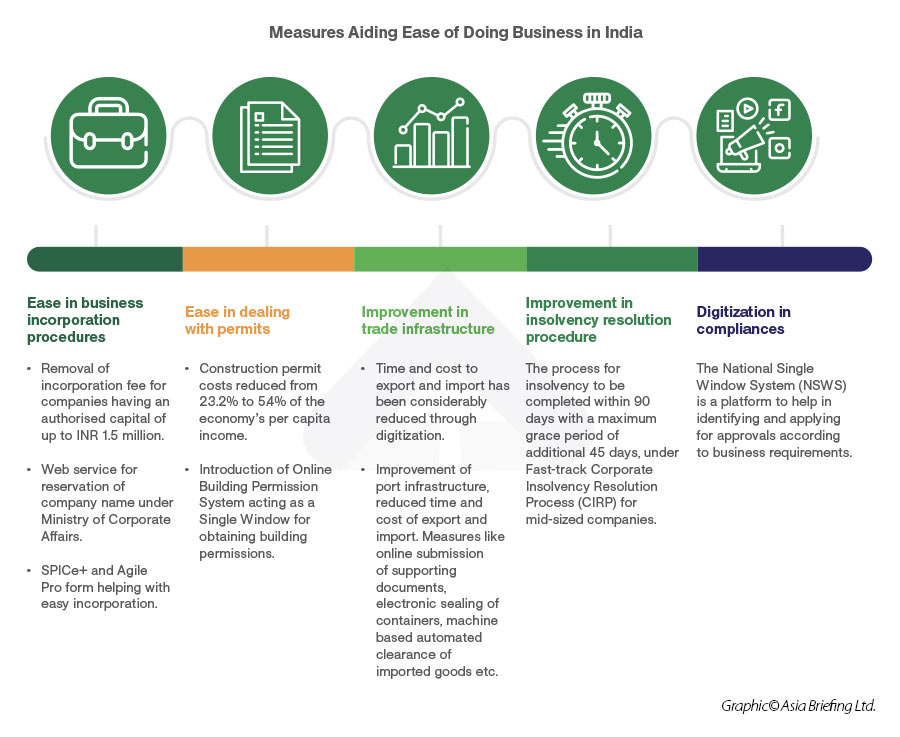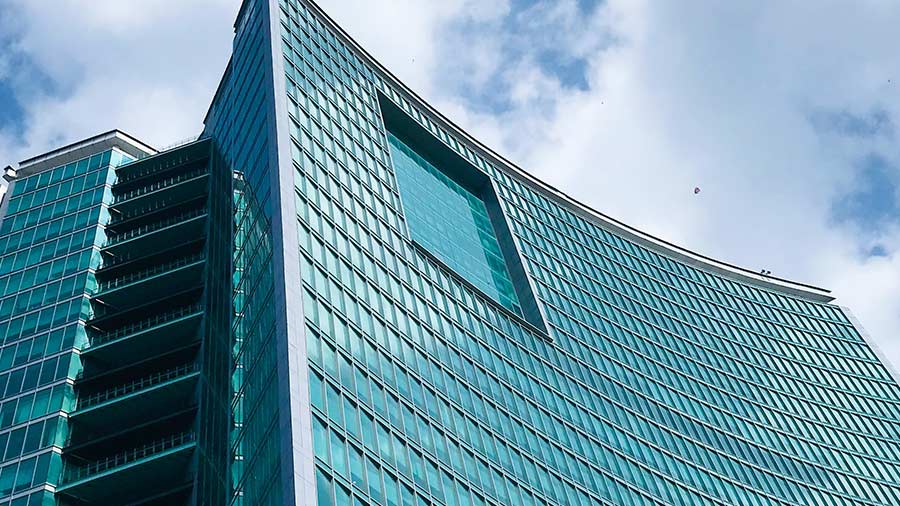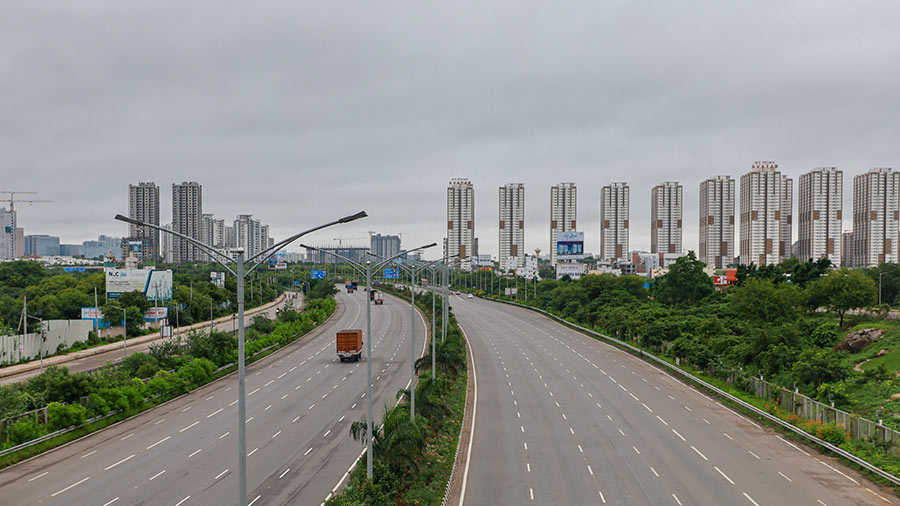Top reasons to invest in India
India's GDP growth for the financial year 2024–25 reached 6.5 percent, driven by a notable surge in economic activity during the fourth quarter. Despite this boost, the annual growth rate marks the slowest since the pandemic-hit year of 2020–21. According to data released by the Ministry of Statistics and Programme Implementation (MoSPI), real GDP growth in Q4 FY 2024–25 rose to 7.4 percent, the highest quarterly expansion of the year, compared to 6.4 percent recorded in the third quarter.
India is expected to maintain its position as the fastest-growing major economy through 2025 and 2026. The economy is projected to grow by 6.2 percent in 2025 and 6.3 percent in 2026, outpacing other large global economies.
| Rank | Country/Region | Continent | GDP (US$ Billion) |
|---|---|---|---|
| 1 | US | America | 29,840 |
| 2 | China | Asia | 18,533 |
| 3 | Germany | Europe | 4,772 |
| 4 | India | Asia | 4,340 |
| 5 | Japan | Asia | 4,310 |
| 6 | UK | Europe | 3,685 |
| 7 | France | Europe | 3,223 |
| 8 | Brazil | America | 2,438 |
| 9 | Italy | Europe | 2,390 |
| 10 | Canada | America | 2,361 |
India’s steady rise in global rankings reflects a combination of factors, including technological advancements, policy interventions, and increasing private sector participation, all of which have contributed to its expanding economic footprint. By 2027, India is anticipated to overtake Germany, securing the third spot in the global rankings.
The country’s robust economic trajectory is underpinned by resilient growth and favorable demographics. After all, India is the most populous country in the world, with a median age of 28.2 years. After a prolonged pandemic, recovery in domestic demand, particularly in private consumption and household spending, should facilitate business expansion plans. India’s large consumer base, rising urban incomes, and the aspirations of the world’s largest young population are feeding into this. A recent World Bank report titled “Navigating the Storm” underlines that the Indian economy has proved remarkably resilient to the ongoing impacts of the deteriorating external environment, growing faster than most major emerging market economies (EMEs).
With the banking system in good health to support the nation’s economic recovery, private-sector investment is anticipated to rise in the forthcoming year, making India the bright spot in the Asian business and investment landscape.
Amidst these conditions, specific trends are also driving further increases in the country’s inbound investment and making India a hotbed for companies from around the world that are seeking to:
- Diversify their Asia presence;
- Access the Indian and South Asian markets;
- Supplement their China operations; and
Leverage highly attractive free trade agreements, production, and market advantages.
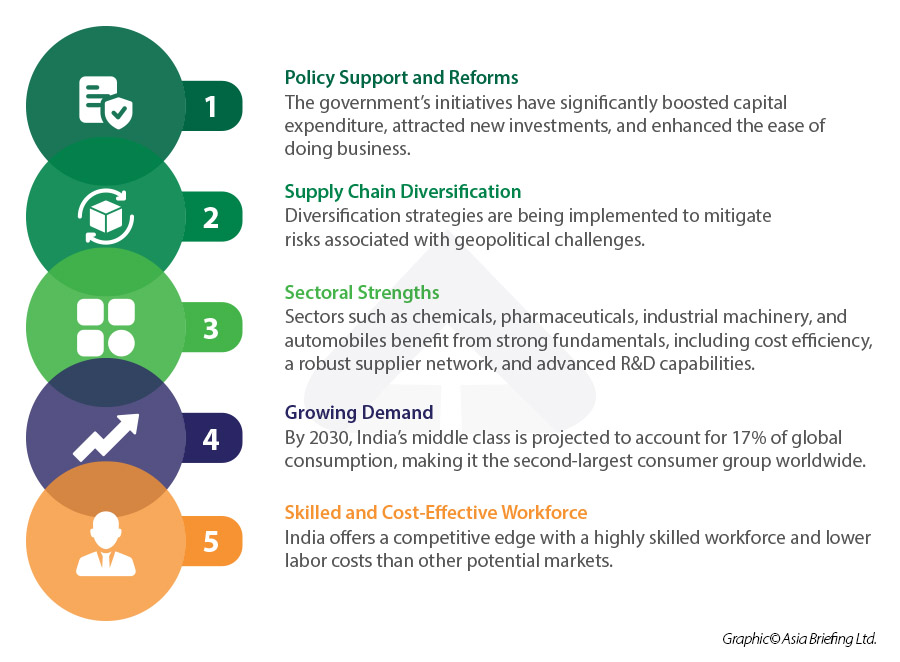
Ease of doing business
India has improved its business climate through comprehensive reforms, rising from 142nd to 63rd in the World Doing Business Report rankings between 2014 and 2020, and now ranks among the top 100 nations in the Ease of Doing Business (EoDB) index. These improvements stem from simplified compliance processes, rationalized redundant laws, and the decriminalization of over 3,400 minor legal provisions. The government has prioritized digitization by implementing online platforms to replace manual paperwork and introducing PAN as a universal identifier for regulatory clearances.
These reforms, including EoDB 2.0 and other policy initiatives, have created a more favorable environment for entrepreneurship and directly contributed to substantial foreign investment growth.
FDI inflows have increased from US$45.14 billion in 2014-15 to a record US$84.83 billion in 2021-22. Between April 2014 and March 2024, India received US$667.41 billion in FDI—nearly 67 percent of the total FDI over the past 24 years. The country's attractiveness as a global investment destination continues to strengthen, with FY 2023-24 seeing total FDI inflows of US$70.95 billion, including equity inflows of US$44.42 billion.
Some of these reforms are:
Economic outlook

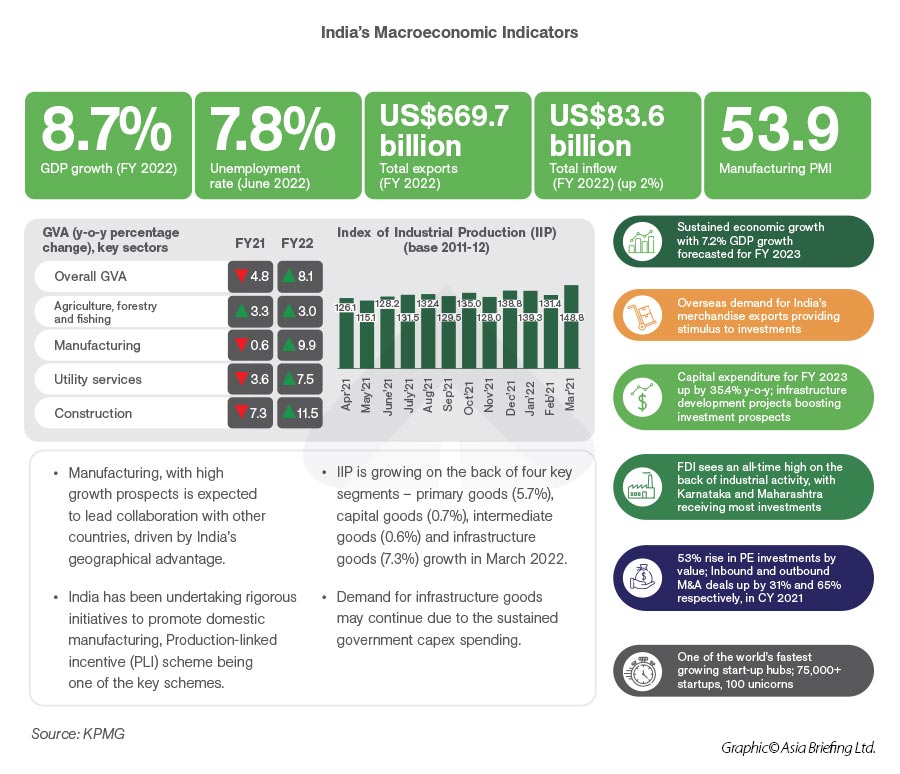
India’s Manufacturing PMI
India’s Manufacturing Purchasing Managers’ Index (PMI) remained firmly in expansion throughout FY 2024–25, indicating sustained momentum in the country’s manufacturing sector. The fiscal year opened strong in April 2024 with a PMI of 58.8, closely matching the previous month’s high of 59.1. Over the course of the year, PMI readings fluctuated within a narrow band between 56.4 and 58.8, reflecting consistent manufacturing activity without major shocks or contractions.
Compared to FY 2023–24, the FY 2024-25 PMI data suggests continued strength in domestic demand, supportive sectoral policies, and improving supply chain conditions.
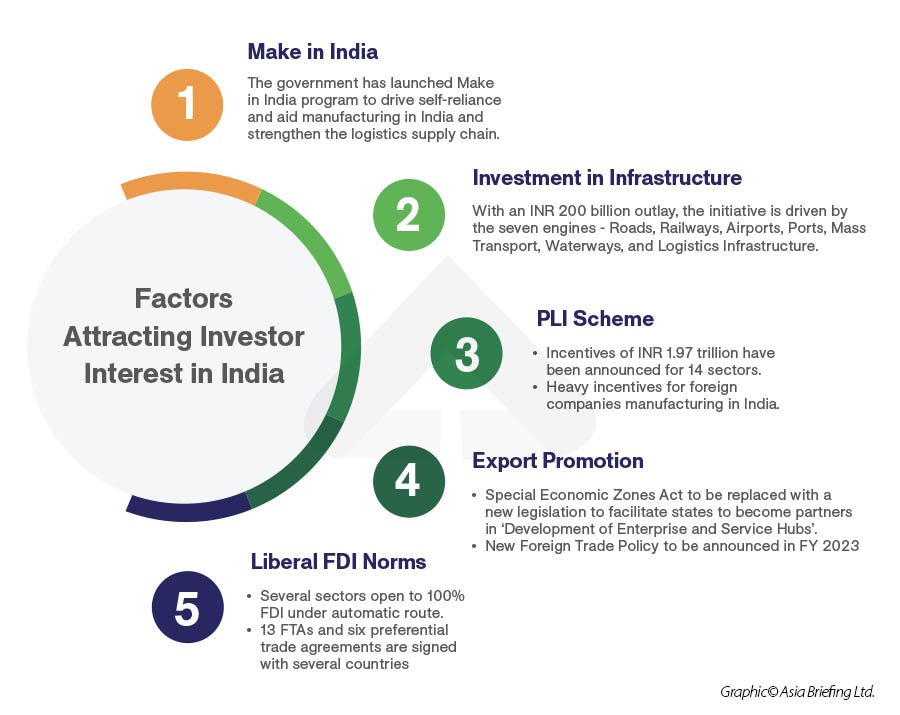
India as a Digital Economy
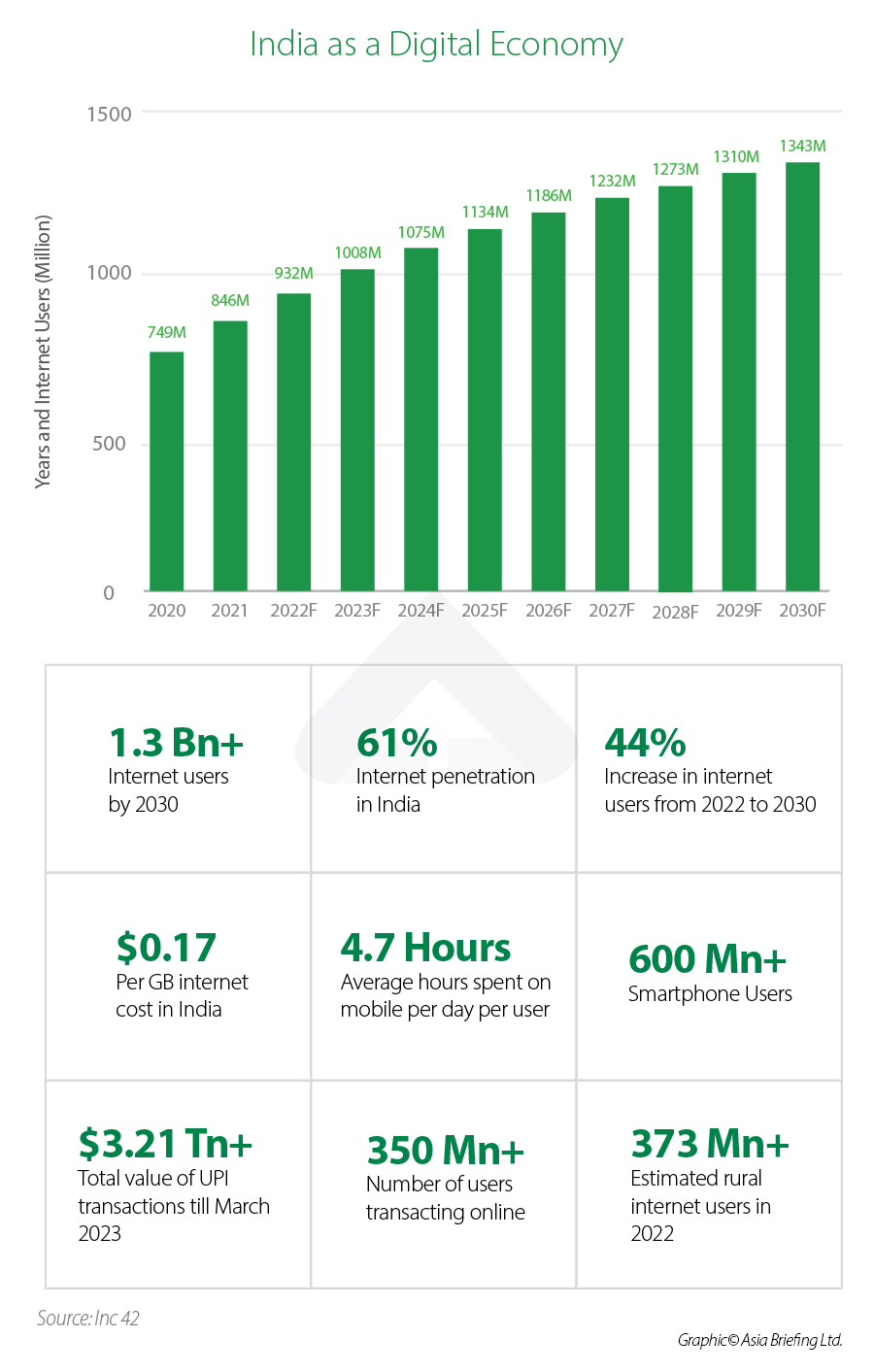
India’s International Free Trade and Tax Agreements
India has been proactively engaging in free trade agreements (FTAs) to strengthen its export-driven manufacturing sector. The country initially set an ambitious export target of US$450–500 billion for FY2023 and aims to reach US$2 trillion by 2030. Export performance has shown consistent growth, with significant increases in both merchandise and services exports.
Over the past five years, India has successfully concluded trade agreements with several partners, including Mauritius, the UAE, and Australia. Notably, the India-UAE Comprehensive Economic Cooperation and Partnership Agreement (CEPA) has been in effect since May 2022, while the India-Australia Economic Cooperation and Trade Agreement (ECTA) was implemented on December 29, 2022.
In March 2024, India signed the Trade and Economic Partnership Agreement (TEPA) with the European Free Trade Association (EFTA), comprising Switzerland, Iceland, Norway, and Liechtenstein. This agreement is a significant milestone as India's first trade pact with four developed economies. TEPA includes investment commitments of US$100 billion and is expected to generate 1 million jobs in India over the next 15 years.
European Union (EU), Oman, Peru, and Sri Lanka, aiming to further expand its trade network and economic partnerships.
|
Country/bloc |
Agreement type |
Status and key updates |
Participating countries |
|
Chile |
CEPA |
On April 1, 2025, India and Chile announced the launch of negotiations for a CEPA to enhance cooperation across trade, science and technology, critical minerals, health, agriculture, climate change, and cultural exchanges. |
India, Chile |
|
New Zealand |
FTA |
Negotiations resumed on March 16, 2025, after a decade-long pause. Bilateral trade exceeded US$1 billion (April–January 2025). |
India, New Zealand |
|
United States |
Trade Agreement |
India and the U.S. aim to double trade to US$500 billion by 2030. Trade deal expected within 6-8 months (as of February 2025). |
India, USA |
|
United Kingdom |
FTA |
Finalized on the 6th of May 2025. The new trade agreement is projected to boost annual bilateral trade between India and the UK by £25.5 billion. |
India, UK |
|
European Union (EU) |
FTA |
Next round of negotiations scheduled for March 10-14, 2025, in Brussels. |
India, 27 EU nations |
|
Oman |
CEPA |
CEPA discussions advanced in January 2025. Talks officially began in November 2023. |
India, Oman |
|
European Free Trade Association (EFTA) |
TEPA |
Signed on March 10, 2024; expected to take effect by late 2025. |
India, Iceland, Liechtenstein, Norway, Switzerland |
|
AITIGA (FTA Review) |
Fifth Joint Committee meeting scheduled for February 2025 in Jakarta. |
India, 10 ASEAN nations |
|
|
Qatar |
Potential FTA |
India and Qatar exploring an FTA to double trade to US$28 billion within five years. |
India, Qatar |
|
Canada |
CEPA |
Negotiations re-launched in March 2022 but paused as of September 2023. |
India, Canada |
|
Gulf Cooperation Council (GCC) |
FTA |
Talks resumed in November 2022, with GCC planning formal discussions in 2025. |
India, Saudi Arabia, UAE, Qatar, Kuwait, Oman, Bahrain |
|
SAARC Nations |
SAFTA (2006) |
Reduces tariffs among SAARC nations. |
India, Afghanistan, Bangladesh, Bhutan, Maldives, Nepal, Pakistan, Sri Lanka |
|
Sri Lanka |
ISFTA (2000) |
Promotes bilateral trade. |
India, Sri Lanka |
|
Nepal |
Treaty of Trade |
Provides duty-free access to primary products. |
India, Nepal |
|
Bhutan |
Trade Agreement |
Eliminates tariffs on multiple goods. |
India, Bhutan |
|
Thailand |
FTA (2004) |
Initiated under the Early Harvest Scheme. |
India, Thailand |
|
CECA |
Covers trade, services, and investment. |
India, Singapore |
|
|
Malaysia |
CECA (2011) |
Covers trade, services, and investments. |
India, Malaysia |
|
Japan |
CEPA (2011) |
Eliminates tariffs on most goods. |
India, Japan |
|
South Korea |
CEPA |
Reduces tariffs and promotes trade. |
India, South Korea |
|
ASEAN |
FTA (2010, expanded 2014) |
Covers goods and services. |
India, ASEAN |
|
Mauritius |
CECPA (2021) |
India’s first trade agreement with an African nation. |
India, Mauritius |
|
CEPA (2022) |
Boosts bilateral trade. |
India, UAE |
|
|
Australia |
ECTA (2022) |
Supports key sectors like agriculture and minerals. |
India, Australia |
|
UAE |
BIT |
Signed in February 2024, effective August 31, 2024, to protect foreign portfolio investments. |
India, UAE |
|
Uzbekistan |
BIT |
Signed in 2024 to enhance investment flows. |
India, Uzbekistan |
|
Bangladesh |
BIT |
Strengthens investment cooperation. |
India, Bangladesh |
|
Belarus |
BIT |
Aims to protect and promote mutual investments. |
India, Belarus |
|
Kyrgyzstan |
BIT |
Enhances economic collaboration through investment protection. |
India, Kyrgyzstan |
|
Thailand |
BIT |
Encourages investment and trade ties. |
India, Thailand |
|
Trinidad & Tobago |
BIT |
Promotes bilateral investments and economic cooperation. |
India, Trinidad & Tobago |
|
Switzerland & Liechtenstein |
BIT (Planned) |
Pushing for BIT after the India-EFTA TEPA agreement. Switzerland suspended the MFN clause in DTAA, leading to higher taxes for Swiss firms. |
India, Switzerland, Liechtenstein |
|
India |
Duty-Free Tariff Preference Scheme |
Covers 46 Least Developed Countries (LDCs). |
India, 46 LDCs |
|
United Kingdom |
Developing Countries Trading Scheme |
Covers 65 developing countries, including India. |
India, UK, 64 others |
|
Armenia |
GSP |
Covers 153 countries, including India. |
India, Armenia, 152 others |
|
Australia |
GSP |
Covers 177 countries, including India. |
India, Australia, 176 others |
|
European Union (EU) |
GSP |
Covers 88 countries, including India. |
India, EU, 87 others |
|
Japan |
GSP |
Covers 130 countries, including India. |
India, Japan, 129 others |
|
Kazakhstan |
GSP |
Covers 153 countries, including India. |
India, Kazakhstan, 152 others |
|
Kyrgyz Republic |
GSP |
Covers 153 countries, including India. |
India, Kyrgyz Republic, 152 others |
|
New Zealand |
GSP |
Covers 140 countries, including India. |
India, New Zealand, 139 others |
|
Norway |
GSP |
Covers 122 countries, including India. |
India, Norway, 121 others |
|
Switzerland |
GSP |
Covers 123 countries, including India. |
India, Switzerland, 122 others |
Double Tax Avoidance Agreements
Double Tax Avoidance Agreements treaties effectively eliminate double taxation by identifying exemptions or reducing the amount of taxes payable in India.
India has one of the largest networks of tax treaties for the avoidance of double taxation and prevention of tax evasion. India has established over 94 comprehensive DTAAs and eight limited DTAAs, compared with China’s 114 and Vietnam’s 80. The purpose of such tax treaties is to develop a fair and equitable system for the allocation of the right to tax several types of income between the ‘source’ and ‘residence’ countries
It is, therefore, extremely worthwhile for foreign investors to be aware of which double taxation avoidance agreements (DTAAs) between India and other countries might be applicable to their situation, as well as understand how these agreements are applied.
Why do businesses relocate to India?
To size up India, or any country, as a potential destination for relocation, it is vital that foreign investors diligently research their options across many factors that are relevant to their situation. Such factors may include infrastructure, locations, talent availability, access to raw materials, incentives, supply chain partners and logistics, and others.
The country has doubled down on efforts to diversify its economy, resulting in the prominence of its services sectors, boosted by information and communication technologies capabilities and English as the lingua franca.
Here are some top reasons (to add to the reasons listed above) why companies choose to relocate to India:
- India is a prime location for foreign multinationals - a major investment hub in South Asia and well-connected to central, west, southeast, and east Asian countries.
- The country has doubled down on efforts to diversify its economy, resulting in the prominence of its services sectors, boosted by information and communication technologies capabilities and the labor forces' English language skills.
- Numerous industrial zones, workforce and labor availability, lower labor costs, and a relatively open environment for foreign direct investments.
- India’s large labor and consumer base, low operating costs, and linkages to important international markets.
- Well-established Judiciary and prevalence of the rule of law.
- India is a democratic, secular republic with a stable political environment and broad consensus across the political spectrum on the direction of the economy.
- Massive investment in infrastructure to improve last mile connectivity, speed up and reduce the cost of carrying goods:
- East and west dedicated rail freight corridors;
- National Infrastructure pipeline;
- Gatishakti; and
- Sagarmala.
India’s advantage as a China +1 destination
As of March 2025, new tariffs imposed by the U.S. on Chinese imports have further complicated this situation, with tariffs rising from 10 percent to 20 percent, prompting China to retaliate with tariffs on American agricultural products. This has pressured foreign-invested businesses that had been reliant on China sourcing or production to diversify or seek alternative destinations.
China’s costs have been rising for more than two decades, in and around its tier 1 and tier 2 cities, and are significantly higher in terms of operating costs than India’s. There is very high competition in China for skilled labor, and coupled with China’s aging population, has resulted in labor shortages in certain manufacturing, high-tech, and other specialized sectors.
On the other hand, in addition to a population of 1.4 billion people, India has a large, young population. More than half of India’s total population is under the age of 25, and two-thirds are less than 35 years of age. By 2027, India is likely to have the world’s largest workforce, with a billion people aged between 15 and 64. Analysts expect this large, young workforce to make a significant contribution to India’s growing consumer base.
India has some of the lowest labor costs in Asia: an hourly labor cost in India is roughly one-third the cost of the same hour in China.
India’s infrastructure development
The Indian infrastructure sector has a multiplier effect on several other sectors. India is expected to become the world’s third-largest construction market by 2025.
To ease progress in India’s infrastructure, the government has implemented policies to minimize bureaucratic delays, which include simplification of land acquisitions, faster clearance/approvals from relevant authorities, using technologies such as online computerized Monitoring System (OCMS) and Pro-Active Governance and Timely Implementation (PRAGATI) to improve project monitoring, and creating cost committees at the federal level to monitor cost overruns.
The government launched the National Infrastructure Pipeline (NIP) for FY 2019-25, under which projects have been identified to construct, refurbish, strengthen, and expand road networks, housing, urban development, railways, conventional power, renewable energy, and irrigation. Key programs will focus on highways and railways.
The Industrial Corridor Projects, part of the National Industrial Corridor program, is an example, and aligns with the development of industrial cities and improving inter-city connectivity so that they can compete with top global investment destinations. In addition, the government has also established a Special Purpose Vehicle for the construction, operation, and maintenance of dedicated freight corridors under the Dedicated Freight Corridor (DFC) program that aims to decongest the existing rail network by constructing dedicated tracks for goods trains. Currently, the construction work for both projects is in full swing.
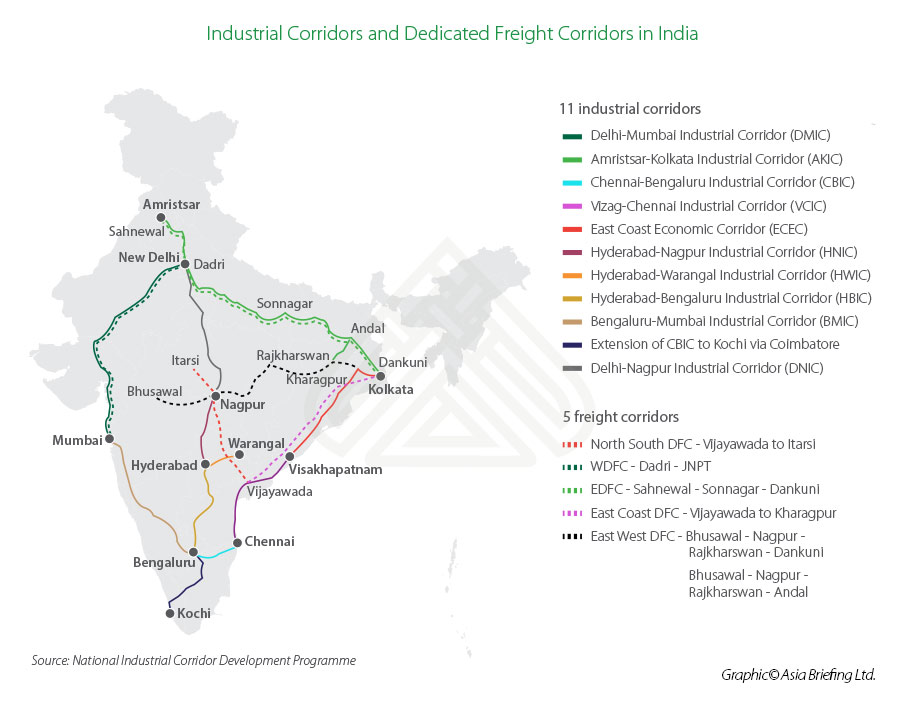
For port infrastructure, since its launch, the Sagarmala Program (2015-2035) has identified more than 574 projects worth INR 6.01 trillion across areas of port modernization and new port development, port connectivity enhancement, port-linked industrialization, and coastal community development.
As of 16th August, 2024 a total of 200 projects have been completed. The states of Gujarat, Maharashtra, Karnataka, Andhra Pradesh, and Tamil Nadu, among the top investment destinations in India, account for the country’s ports and sea routes.
Incentives, workforce, and economic zones
Incentives for doing business in India
There are various incentives available to businesses depending on the economic activity, industry, location, and size of the firm.
India offers tax relief at both the central and state level. Additional incentives are available to investors in specific sectors, while India’s special economic zones (SEZs) offer their own comprehensive tax relief. However, not all tax benefits offered are mutually inclusive.
Corporate tax incentives for eligible companies
- Tax on domestic companies engaged in manufacturing, set up after April 1, 2016, shall be a 25 percent rate provided such companies do not avail specific tax incentives or deductions.
- With effect from April 1, 2020 the corporate income tax rate for domestic companies is 22 percent rate, provided such companies do not avail of specific tax incentives or deductions.
- Tax on new domestic manufacturing companies set up after October 1, 2019, is 15 percent, provided such new manufacturing company is set up before March 31, 2024.
The concessional tax regime (22 percent) for domestic enterprises is applicable only if they do not avail of specific tax incentives or deductions. (The effective tax rate for these domestic companies is around 25.17 percent inclusive of surcharge and cess.)
Those companies opting for the concessional corporate tax rate do not have to pay minimum alternate tax. India’s current effective tax rate brings it at par, on average, with leading Asian investment destinations and manufacturing hubs like China, Vietnam, Malaysia, Singapore, and South Korea.
| Section | Tax Incentive | Details |
|---|---|---|
| Export Businesses | Tax Deduction on Profits and Gains |
|
| Start-ups | Tax Benefits for Eligible Start-ups |
|
| Additional Tax Advantages | Tax Concessions |
|
| Industry Investment | Capital Expenditure Deductions | Immediate deductions for capital expenditure in designated business areas |
| Sector-Specific Benefits | Infrastructure & Renewable Energy |
|
| Special Economic Zones (SEZs) | SEZ Tax Relief |
|
| Notes: * Capital gains concession varies by asset class and holding period ** MAT relief available under specific conditions *** DDT was abolished in 2020; dividends are now taxed in shareholders' hands |
||

Other incentive types
Several other types of incentives are offered by the Indian government in qualifying, special circumstances. These are explained in our incentives guide.
Foreign companies choosing where to set up in any of India’s states should note that each region has its own set of policies and incentive schemes. The applicability of incentives usually varies based on:
- The state’s location;
- The products that will be manufactured;
- The scale of investment; and
- The creation of jobs.
India’s promising workforce
India possesses a large labor pool, with approximately 64.4 percent of its 1.4 billion population in the working-age group, a figure expected to rise further by 2031. Naturally, the structure of India’s labor market is diverse, and foreign companies must understand this complexity to benefit from the country’s demographic dividend.
A significant portion of the working population is engaged in the informal sector, working for small businesses or manufacturing units that employ fewer than ten individuals. For businesses that do not require highly skilled labor, sourcing workers remains relatively accessible due to this wide labor base.
While the expansion of higher education and vocational training has improved access to skilled talent, formally skilled workers still represent only about 4.7 percent of the labor force. Additionally, only around 12 percent of the workforce holds university-level qualifications. Companies seeking skilled labor must be prepared to compete aggressively for talent within this comparatively limited pool.
Labor costs in India
Firms considering entry into the Indian market often evaluate labor costs as a critical decision factor. India continues to offer a competitive edge due to its low wage structure and expansive labor supply. For instance, minimum wages are not fixed nationally but vary by state and job category. The lowest daily wage rate starts at INR 176 (US$2.11), while in high-cost regions like Delhi, it can go up to INR 423 (US$5.08) per day.
Employers should note that these rates represent floor-level benchmarks, commonly used for unskilled and semi-skilled labor, especially in the manufacturing sector.
Labor costs also differ significantly by region. In tier-2 and tier-3 cities, wages can be up to 25 percent lower than in tier-1 cities due to reduced costs of living and benefits. For instance, the average annual salary of a software engineer in New Delhi is around US$9,600–10,800, while in Mysore, it may range from US$6,500–8,000, depending on experience and role. These disparities make regional site selection a strategic factor in workforce planning.
Special Economic Zones
Special economic zones (SEZs) in India are areas that offer incentives to resident businesses. SEZs typically offer competitive infrastructure, duty-free exports, tax incentives, and other measures designed to make it easier to conduct business. Accordingly, SEZs in India are a popular investment destination for many multinationals, particularly exporters.
While India’s SEZs are similar to those found in other parts of Asia, business leaders who are considering setting up a SEZ should seek to understand how SEZs work in India. Each SEZ is unique. Many business leaders conduct market entry studies that compare sites, resources, tax incentives, and costs before making site visits.
Summary: Top 10 reasons to invest in India
|
1. |
Strategic Location |
Strategic destination for manufacturing and China +1, a major investment hub in South Asia, and well connected to central, west, southeast, and east Asian countries |
|
2. |
Growing Economy |
Strong economic GDP growth, including continuing annual GDP growth, competing consistently with global and regional peers. |
|
3. |
Network of SEZs |
Multiple SEZs offer competitive infrastructure, duty-free exports, tax incentives, and other measures designed to make it easier to conduct business. |
|
4. |
Ease of Doing Business |
Improving ease of doing business for foreign investors. |
|
5. |
Large, young labor force |
By 2027, India is likely to have the world’s largest workforce, with a billion people aged between 15 and 64. |
|
6. |
Incentives for Doing Business |
There are various incentives available to businesses depending on the economic activity, industry, location, and size of the firm. |
|
7. |
Strong FDI Environment |
Most sectors are open to FDI.
|
|
8. |
Progress in Infrastructure Development |
Major infrastructure schemes like Bharatmala (roads), Sagarmala (ports), UDAN (airports), and Gati Shakti (multi-modal logistics) are bridging India’s infrastructure gap, enhancing business efficiency and logistics. |
|
9. |
Network of FTA's and DTAs |
India has over 13 active FTAs (e.g., with UAE, Japan, ASEAN, Australia, Mauritius) and more than 90+ Double Taxation Avoidance Agreements (DTAAs), easing trade and tax burdens for foreign investors. |
|
10. |
Integration with Legal Frameworks |
India is a WTO member and party to global IP, patent, and trade protection treaties (TRIPS, Berne Convention, WIPO, etc.), providing strong legal backing for cross-border investments and IP rights. |




